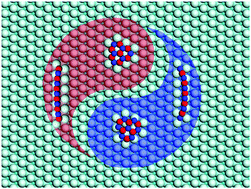The geometry of hexagonal boron nitride clusters in the initial stages of chemical vapor deposition growth on a Cu(111) surface†
Abstract
To understand the nucleation process in the growth of hexagonal boron nitride (h-BN) on transition metal substrates by chemical vapor deposition (CVD), the energy of formation and stability of h-BN clusters of different geometries on a pristine Cu(111) surface were systematically investigated using density functional theory calculations. We find that unlike carbon clusters, h-BN clusters on Cu supports can undergo two possible transformations of the minimum-energy structure at a critical size of 13. Different from freestanding h-BN clusters, on a Cu(111) surface, h-BN chains are more stable than h-BN rings and thus dominate the minimum-energy structure for cluster sizes lower than the critical size. Thus, depending on the experimental conditions of CVD, one-dimensional Bn−1Nn (N-rich environment) or BnNn−1 (B-rich) chains are first created, and they transform to two-dimensional sp2 networks or h-BN islands, but for a BnNn chain, the transformation to a two-dimensional sp2 network h-BN island does not occur. In contrast to carbon islands where pentagons are readily formed, odd-membered rings are extremely rare in h-BN islands, where the transformation to the most stable structure occurs through a combination of trapeziums and hexagons at the edges, so as to avoid B–B and N–N bonds. Moreover, on a Cu(111) surface, trapeziums are destabilized when the four edges are connected to other hexagons because of additional curvature energy, thus favoring the nucleation of planar nuclei. A deep insight into h-BN cluster formation on a Cu support is vital to understanding the growth mechanism of h-BN on a transition metal surface in CVD experiments to further improve experimental designs in the CVD growth of h-BN.



 Please wait while we load your content...
Please wait while we load your content...